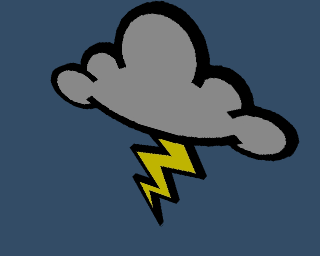ClipArt
vtk-examples/Cxx/Visualization/ClipArt
Description¶
This is an adaptation of the VTK test clipArt.tcl. Provide a jpg file with 2D clipart and the example will create 3D polydata model. The examples illustrates a number of VTK classes including vtkImageThreshold, vtkImageSeedConnectivity, vtkDecimatePro and vtkClipPolyData.
The example assumes that the image has a white background. Try it with this src/Testing/Data/stormy.jpg.
Question
If you have a question about this example, please use the VTK Discourse Forum
Code¶
ClipArt.cxx
#include <vtkActor.h>
#include <vtkCamera.h>
#include <vtkClipPolyData.h>
#include <vtkDecimatePro.h>
#include <vtkImageDataGeometryFilter.h>
#include <vtkImageExtractComponents.h>
#include <vtkImageGaussianSmooth.h>
#include <vtkImageRGBToHSV.h>
#include <vtkImageSeedConnectivity.h>
#include <vtkImageShrink3D.h>
#include <vtkImageThreshold.h>
#include <vtkJPEGReader.h>
#include <vtkLinearExtrusionFilter.h>
#include <vtkNew.h>
#include <vtkPolyDataMapper.h>
#include <vtkProperty.h>
#include <vtkRenderWindow.h>
#include <vtkRenderWindowInteractor.h>
#include <vtkRenderer.h>
#include <vtkTexture.h>
#include <vtkTextureMapToPlane.h>
#include <vtkTriangleFilter.h>
#include <vtkInformation.h>
#include <vtkStreamingDemandDrivenPipeline.h>
#include <iostream>
#include <string>
int main(int argc, char* argv[])
{
if (argc < 2)
{
std::cout << "Usage: " << argv[0] << " Filename(.jpg) e.g. stormy.jpg"
<< std::endl;
return EXIT_FAILURE;
}
vtkNew<vtkJPEGReader> imageIn;
imageIn->SetFileName(argv[1]);
// Convert the image to hsv so that we can threshold on value.
vtkNew<vtkImageRGBToHSV> toHSV;
toHSV->SetInputConnection(imageIn->GetOutputPort());
// Just work with the value
vtkNew<vtkImageExtractComponents> extractImage;
extractImage->SetInputConnection(toHSV->GetOutputPort());
extractImage->SetComponents(2);
// Threshold to a black/white image.
vtkNew<vtkImageThreshold> threshold1;
threshold1->SetInputConnection(extractImage->GetOutputPort());
threshold1->ThresholdByUpper(230);
threshold1->SetInValue(255);
threshold1->SetOutValue(0);
threshold1->Update();
// Place a seed in each corner and label connected pixels with 255.
threshold1->UpdateInformation();
int* extent = threshold1->GetOutputInformation(0)->Get(
vtkStreamingDemandDrivenPipeline::WHOLE_EXTENT());
vtkNew<vtkImageSeedConnectivity> connect;
connect->SetInputConnection(threshold1->GetOutputPort());
connect->SetInputConnectValue(255);
connect->SetOutputConnectedValue(255);
connect->SetOutputUnconnectedValue(0);
connect->AddSeed(extent[0], extent[2]);
connect->AddSeed(extent[1], extent[2]);
connect->AddSeed(extent[1], extent[3]);
connect->AddSeed(extent[0], extent[3]);
// Smooth a little before clipping.
vtkNew<vtkImageGaussianSmooth> smooth;
smooth->SetDimensionality(2);
smooth->SetStandardDeviation(1.0, 1.0);
smooth->SetInputConnection(connect->GetOutputPort());
vtkNew<vtkImageShrink3D> shrink;
shrink->SetInputConnection(smooth->GetOutputPort());
shrink->SetShrinkFactors(1, 1, 1);
shrink->AveragingOn();
// Convert the image to polydata.
vtkNew<vtkImageDataGeometryFilter> geometry;
geometry->SetInputConnection(shrink->GetOutputPort());
// Create texture coordinates
vtkNew<vtkTextureMapToPlane> geometryTexture;
geometryTexture->SetInputConnection(geometry->GetOutputPort());
geometryTexture->SetOrigin(0, 0, 0);
geometryTexture->SetPoint1(extent[1], 0, 0);
geometryTexture->SetPoint2(0, extent[3], 0);
// Clip the geometry.
vtkNew<vtkClipPolyData> clip;
clip->SetInputConnection(geometryTexture->GetOutputPort());
clip->SetValue(5.5);
clip->GenerateClipScalarsOff();
clip->InsideOutOff();
clip->InsideOutOn();
vtkNew<vtkTriangleFilter> triangles;
triangles->SetInputConnection(clip->GetOutputPort());
vtkNew<vtkDecimatePro> decimate;
decimate->SetInputConnection(triangles->GetOutputPort());
decimate->BoundaryVertexDeletionOn();
decimate->SetDegree(100);
decimate->PreserveTopologyOn();
decimate->SetTargetReduction(.99);
vtkNew<vtkLinearExtrusionFilter> extrude;
extrude->SetInputConnection(decimate->GetOutputPort());
extrude->SetExtrusionTypeToNormalExtrusion();
extrude->SetScaleFactor(-10);
vtkNew<vtkPolyDataMapper> map;
map->SetInputConnection(extrude->GetOutputPort());
map->ScalarVisibilityOff();
vtkNew<vtkTexture> imageTexture;
imageTexture->InterpolateOn();
imageTexture->SetInputConnection(imageIn->GetOutputPort());
vtkNew<vtkActor> clipart;
clipart->SetMapper(map);
clipart->SetTexture(imageTexture);
// Create the RenderWindow, Renderer and Interactor.
vtkNew<vtkRenderer> renderer;
vtkNew<vtkRenderWindow> renderWindow;
renderWindow->AddRenderer(renderer);
renderWindow->SetWindowName("ClipArt");
vtkNew<vtkRenderWindowInteractor> interactor;
interactor->SetRenderWindow(renderWindow);
renderer->AddActor(clipart);
// Create a nice view.
renderer->ResetCamera();
renderer->GetActiveCamera()->Azimuth(30);
renderer->GetActiveCamera()->Elevation(30);
renderer->GetActiveCamera()->Dolly(1.5);
renderer->ResetCameraClippingRange();
renderer->SetBackground(0.2, 0.3, 0.4);
renderWindow->SetSize(320, 256);
interactor->Initialize();
renderWindow->Render();
interactor->Start();
return EXIT_SUCCESS;
}
CMakeLists.txt¶
cmake_minimum_required(VERSION 3.12 FATAL_ERROR)
project(ClipArt)
find_package(VTK COMPONENTS
CommonCore
CommonExecutionModel
FiltersCore
FiltersGeometry
FiltersModeling
FiltersTexture
IOImage
ImagingColor
ImagingCore
ImagingGeneral
ImagingMorphological
InteractionStyle
RenderingContextOpenGL2
RenderingCore
RenderingFreeType
RenderingGL2PSOpenGL2
RenderingOpenGL2
)
if (NOT VTK_FOUND)
message(FATAL_ERROR "ClipArt: Unable to find the VTK build folder.")
endif()
# Prevent a "command line is too long" failure in Windows.
set(CMAKE_NINJA_FORCE_RESPONSE_FILE "ON" CACHE BOOL "Force Ninja to use response files.")
add_executable(ClipArt MACOSX_BUNDLE ClipArt.cxx )
target_link_libraries(ClipArt PRIVATE ${VTK_LIBRARIES}
)
# vtk_module_autoinit is needed
vtk_module_autoinit(
TARGETS ClipArt
MODULES ${VTK_LIBRARIES}
)
Download and Build ClipArt¶
Click here to download ClipArt and its CMakeLists.txt file. Once the tarball ClipArt.tar has been downloaded and extracted,
cd ClipArt/build
If VTK is installed:
cmake ..
If VTK is not installed but compiled on your system, you will need to specify the path to your VTK build:
cmake -DVTK_DIR:PATH=/home/me/vtk_build ..
Build the project:
make
and run it:
./ClipArt
WINDOWS USERS
Be sure to add the VTK bin directory to your path. This will resolve the VTK dll's at run time.
